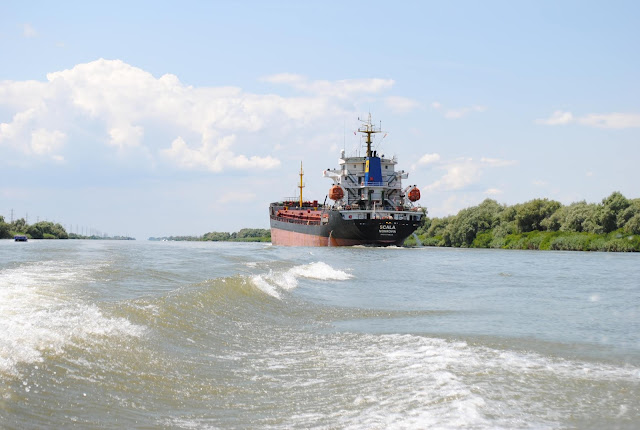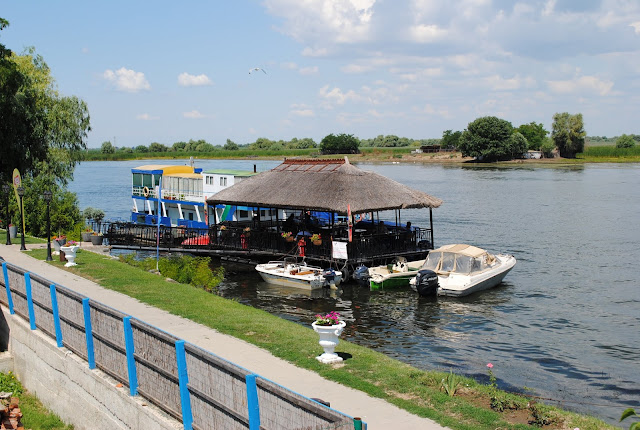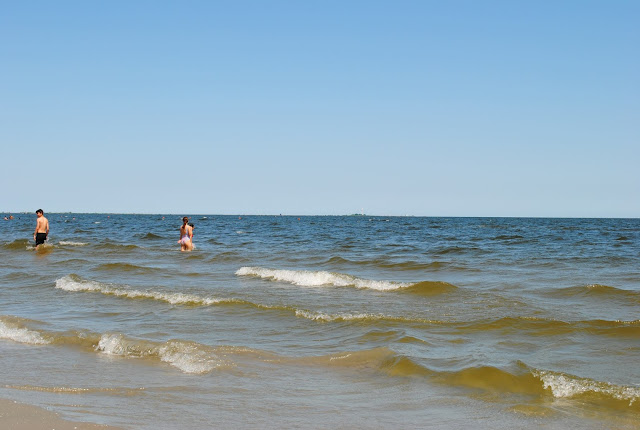Well, it's Saturday morning and we're going to have lunch before we set out on the boat for a tour of the Danube Delta wetlands.
We are staying at a wonderful hotel in the town named Tulcea. Here's a little historical information about the town, which I found fascinating. Tulcea was founded in the 7th century BC under the name of Aegyssus, mentioned in the documents of Diodorus of Sicily (3rd century BC). In his Ex Ponto, Ovid recorded a local tradition that ascribed its name to a mythical founder, Aegisos the Caspian.
After the wars from 12-15 A.D. the Romans conquered the town. They rebuilt in accordance with their techniques and architectural vision. The fortified town was mentioned in documents as late as the 10th century.
Under Byzantine rule beginning with the 5th century AD, the town was abandoned by the first half of the 7th century due to the Barbarian invasions. The former settlement's territory fell under the rule of the Bulgarian Empire (681-1000; 1185-14th century). Inhabitation was restored in the second half of the 10th century, as the Byzantines built a fortress on the spot after reconquering the region. The fortress was soon destroyed in 1064 by an attack of the Uzes, however some inhabitation continued. A settlement, larger than the one in the 11th century, is archaeologically attested beginning with the 14th century. The Ottoman rule was imposed around 1420, and would last for the following four centuries.
The town was first documented under its modern name in 1506, in the Ottoman customs records. In those records, it was described as an "important center for the transit trade" from the Black Sea to the Danube River.
The Danube Delta (or in the Romanian: Delta Dunării) is the second largest river delta in Europe, after the Volga Delta, and is the best preserved on the European continent. The largest part of the Danube Delta lies in Romania (Tulcea County where we were staying), with a small part in Ukraine. It takes up a surface area of 1,603 sq mi, of which 1,331 sq mi is in Romania. With the lagoons of Lacul Razim, where I was yesterday at the Enisala Fortress located south of the main delta, the total area of the Danube Delta is 1,994 sq mi. The Lacul Razim lagoon complex is geologically and ecologically related to the delta proper and the entire territory is listed as a World Heritage Site.
Here is a typical Romanian breakfast we enjoyed both mornings we were at the hotel - definitely NOT what you'd find at an IHOP. Poached eggs, cheeses, bacon, olives, tomatoes, and cucumbers. It was super yummy!
It's a little hard to see but on the tops of some utility poles are stork nests. THEY ARE ENORMOUS! I'll see if I can find some closer up as we travel.
There are two submarines on the back of this ship... I should look up the registry and see what it does. It's a giant ship though.
Here are the Romanian Marine Police...better be careful here.
Hmmm? Something sunk here?
This is kinda hard to explain in a picture but this lighthouse used to be on the water to guide ships down the Danube. Over time, the river curved and the lighthouse wa now almost a quarter of a mile inland...they had to build a new lighthouse down the river a little ways which I got a picture of.
We left the main part of the Danube and headed off into the tributaries and channels in search of wildlife. The Danube Delta is a magnet for birds from six major ecoregions of the world, including the Mongolian, Arctic, and Siberian. There are over 320 species of birds found in the delta during summer, of which 166 are hatching species, and 159 are migratory. Over one million individual birds (swans, wild ducks, coots, etc.) winter here. That's a lot of birds.

We've left the tributaries to head further south into the delta. We had already traveled about two hours so we were off to places closer to the Black Sea. There are wild horses down here and maybe I'll catch a glimpse. I talked to Nicu about the horses. He said there are no wild horse. Many years ago some horses got loose and ran away into the delta. They reproduced and - wild horses. He said they are not just "wild horses" who evolved here. It was pretty funny.
Here's a fellow traveler passing on a boat, I thought it was a cute picture! Now we're going back into the channels and tributaries.
Here's something else I've never seen - a BOATEL. It's a hotel on a boat. It was huge!
This a really big lily pad area, its kinda cool. Let's go in closer to take a look.
The water is so clear you can see nearly to the bottom. There are frogs, turtles, and snakes; we saw many but they are REALLY hard to photograph from a moving boat.
Here's our crew! I was way in the back of the boat. As we were zooming along, my hat (my favorite Harley-Davison ball cap) blew off my head and grabbed my eyeglasses with them. FORTUNATELY they landed on the back where the engine mounts and didn't fly into the river! I was really lucky.
Here's something I don't see too often - ok, NEVER. It's a boat gas station!
Here's a restaurant named "Alexandru si Alexandra" we stopped at for lunch. It is in a town called "Mile 23." Can you guess what that means? Mila 23 is a small and chic village right in the heart of the Danube Delta. If you want to find out what it feels like to live completely surrounded by water, than this is the place to visit.
It is located on the left bank of the old course of the Sulina channel, which was shortened and better prepared to suit navigation needs back in the nineteenth century. Without winning too many points for originality, the village has this name because the Sulina channel measured exactly 23 miles at this point (measured from the river’s mouth) following its old course. This was before the European Commission of the Danube straightened this part of the river over a century ago.
The only way to get there is by boat, which makes it the perfect retreat for all you nature loving enthusiasts (like me) or for somebody who simply wants to get away from the busy daily life (like me).
The villagers of Mila 23 are mostly Lipovans, Russians, and Ukrainians who support themselves through fishing on the Danube River. The Lipovans were the ones who founded the village in the early nineteenth century and they currently represent about two thirds of the population.
I learned a lot from my friend Nico this day. The Lipovans or Lippovans or as Romanians call them, Lipoveni, are known as the Old Believers. They are mostly of Russian ethnic origin, who settled in Romania in the Moldavian Principality, and in the regions of Dobruja and Eastern Muntenia. There are about 35,000 Lipovans in Romania, of whom over 21,000 live in Dobruja alone.
The Lipovans emigrated from Russia in the 18th century, as dissenters from the main Russian Orthodox Church. They settled along the Prut River in Moldavia and in the Danube Delta to escape persecution. They have maintained strong religious traditions which predate the reforms of the Russian Orthodox Church which occurred during the rule of Patriarch Nikon (see below for more information about Nikon (no he didn’t invent cameras). When the Patriarch made changes to worship in 1652, some believers carried on worshipping in the "old way". In that sense, they continued to speak Old Russian, to cross themselves with two fingers instead of three, and to keep their beards. The older Lipovan men wore their beards as part of their religious culture and during the days when they were persecuted, bearded men had to pay extra tax to the State to keep their beards. The population is popularly known as having red hair.
Nico told me this is a Lipovan fisherman. He knew by the boat and the beard.
Nikon, born Nikita Minin (7 May 1605 – 17 August 1681) was the seventh Patriarch of Moscow and all Rus' of the Russian Orthodox Church, serving officially from 1652 to 1666. He was renowned for his eloquence, energy, piety, and close ties to Tsar Alexis of Russia. Nikon introduced many reforms which eventually led to a lasting schism known as Raskol in the Russian Orthodox Church. For many years, he was a dominant political figure, often equaling or even overshadowing the Tsar. His liturgical reforms were unpopular among conservatives. In December 1666, Nikon was tried by a synod of church officials, deprived of all his sacerdotal functions, and reduced to the status of a simple monk.
In 1876, the Lipovans were joined by members of the Skoptsy sect, who also emigrated to Romania to escape persecution.
In 1966 Mila 23 was isolated from the world by political barriers so visitors from outside were largely Romanians or other East Europeans who brought their socialist culture. The Russian government and the Orthodox Church persecuted them, and as a result some committed suicide by burning themselves (self-burning/emolation or soshigateli), with many others being forced to emigrate.
The main center of the Lipovan community is in Ukraine is the town of Vylkove. In order to build their homes in the delta, the Lipovans created islets of dry land by digging mud out from trenches and creating a series of canals. The house walls are made of reed and mud, and reed thatching is standard for the roofing. Because of the characteristics of these reclaimed land and the materials from which the houses are built (very heavy mud bricks), the buildings tend to sink into the mud and need to be rebuilt every few years.
Just walking through the village for a very short time, I saw how the people live and build their houses and other necessities (boats, fishing gear, etc.) out of traditional materials they could still gather from the nearby area. Of course, as times evolve and outsiders enter the scene, newer materials ad products are entering the villages.
Getting here was pretty easy by boat from our hotel in Tulcea.
Because of its location on the Danube, surrounded by a myriad of lakes, channels, tributaries, and canals, Mila 23 is one of the best places where you can enjoy a bird watching trip, catch some great fish, or relax among the endless fields of lilies.
Mila 23 is probably best known for the fact this is where Ivan Patzaichin was born in 1949. Ivan Patzaichin is a Romanian canoe racing coach and retired sprint canoeist. He took part in all major competitions between 1968 and 1984, including five consecutive Olympics, and won seven Olympic and 22 world championship medals, including four Olympic gold medals.
The staff were advised we were coming and they set an incredible table filled with food from the local area. The first course was an assortment of steamed fish and vegetables.
The second course was an assortment of fried fish and polenta. It was incredible to eat what they had just caught this morning. The wait staff was courteous and personable and fun to talk to - maybe they don't get too many English-speaking people here?
After lunch, we were back on our boat and headed to the Black Sea.
Why was I so surprised to find jellyfish in the Black Sea? I dunno, but here they are!
Because this beach is located on an island only accessible by boat, it is pretty isolated and great to get away from all the people. There were miles and miles of beautiful beach - and no people!
And what do I find here on the beach? HORSE TRACKS - with no shoes - horses walking barefoot in the sand.
The gang enjoys a little volleyball.
The day is over at the beach and it' time to head back for dinner. It's more than two hours to the hotel from here.
This is really interesting because all these people are waiting on the bridge for the boat taxi back to some of the other islands around the delta.
We arrived back at the restaurant and none of the kids wanted any more fish. So we headed into town to a restaurant known for their burgers and pizza. It's called "Deep 3".
Ok, here's a quiz. Who has seen bathroom like the one below? Oooo Oooo Oooo, ME!!! I remember these when I was in Italy my first time. This one you need to back into and you better have good aim. Let me tell you a funny story about Noreen in one of these back 30 years ago!
I wanted something other than fish so I tried the most traditional Romanian dish of them all - Mici (pronounced MEECH). It is like a small rolled meatloaf, usually half ground pork and half ground beef. It was very yummy.
For a main course - pasta carbonara, one of my all time favorites. It was very good with ham instead of bacon (but I'll take the bacon version every time).
Nico enjoyed some fried smelt (anchovies for them). I told him how I like to cook smelt and he liked the idea. These were pretty good (he shared some with me).
Time for bed, our day on the water was exhausting. At least the children behaved so it was an enjoyable day overall. Tomorrow is a day filled with mountain climbing in the oldest mountains in Romania - 265 million years!




























































































































Amazing.... storks, poached eggs, Romania!(ar)
ReplyDelete